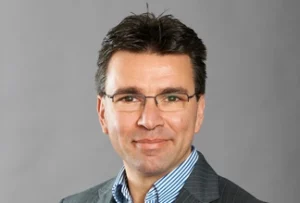
One of Gunnar Menzel’s passions is long-distance running. Menzel, who is Capgemeni’s Chief Technology and Innovation Officer for North and Central Europe, has run dozens of half-marathons and more than a half-dozen full marathons.
It’s a passion that requires a great deal of discipline and dedication, something Menzel has plenty of. In fact, those same qualities, along with many others, have helped him create a successful career in technology.
We wanted to learn to more about Menzel, who has worked in the IT industry for 33 years, so we reached to him to hear his story. The exclusive interview follows.
Question: At what point in your life did you know you wanted to pursue a career in technology?
Answer: I grew up in Germany and I finished my GCSEs (after 10 years in school) a couple of years before the internet was invented. IT was not as accessible as it is today, and it was more of a coincidence that 34 years ago I earned a software engineering degree. It was my math teacher who suggested it, as he thought I would enjoy a job as a developer. I remember using assembler to calculate PI to the 12th digit, which took hours to run on an IBM PS/2. Today, a fast PC can calculate PI to the 1billionth digit in a matter of minutes.
When I started the degree program, I was not quite sure if that was really what I wanted to do. But I soon realized that developing a program that could solve a problem or that delivers some new capabilities to someone was something I really enjoyed. It was the design process that really captivated me; the process of eliciting requirements to then working together with a large variety of stakeholders to develop the solution. So, I pursued a software development career for the first 7 years. I then quickly moved into infrastructure, having built, and deployed the first internet banking web apps for Deutsche Bank in the mid-1990s before moving into architecture. I do remember the point when I realized that I was more of an architect than an engineer. I started to ask why something was needed, and not “just” by when. This was about the turn of the millennium and since then I have been an infrastructure, solution, application, and enterprise architect.
Q: Who have been some of your mentors over your career?
A: One of my mentors was the math teacher I referred to above. I never ever went back to him to explain the impact the conversation in the old classroom had on me and my life. I wish he knew. I wish he knew that that 10-minute conversation paved the way to where I am today. I don’t think that he saw himself as my mentor. He just noted something he thought was worth mentioning to me. Most of the time you never really know or understand that you are inadvertently mentoring someone. A colleague, with whom I worked 15 years ago, told me only last week that I had been the biggest influence on his career. He said I recognised that he was an architect before he did. I have not had any contact with him for years and knowing that I had such an impact on his professional career is amazing. It’s one of the best things that can happen to you in my view. Over the years I have had several mentors who shaped, directed, and influenced my career. Some of the most important guidance I received was to stay authentic and never to lose the connection to content. The latter was something I was told when I was promoted to vice president, and it stayed with me ever since.
Q: You have a diverse background across many different industries, how does that support what you do for Capgemini?
A: I always saw technology as being important, but also as a means to an end. The end in my case was the business impact. Technology is nothing if not providing value to an end user. So, whenever I work on a technology solution I always first try to “understand” the business. I was working for a large UK based retailer in 2002, leading the program to replace all in-store IT. Instead of starting to write the high-level design, I asked to work in a store at the till and on the shop floor. Of course, this is not always possible. However, my aspiration is always the same – trying to understand the business. I worked in the banking sector where I worked on projects like replacing all 40,000 branch PCs, deploying the first internet banking web apps, and shifting the entire IT organization from waterfall to agile. Or in the insurance sector, where I transformed a traditional on-premises case handling system to AWS, as well as several large transformation projects across sectors like public, manufacturing, transport, aerospace, and defense, as well as retail. Having worked across these enabled me to provide a different perspective, finding a new way of solving a problem, challenge, or a requirement.
Q: How does your new role – CTIO for North & Central Europe – differ from your previous responsibilities?
A: For most of my career I was in project and service delivery, where I was typically the lead architect responsible for planning, designing, developing, implementing, and operating solutions. I was accountable for ensuring we do deliver value for money, that the solution was delivered within the timeline defined and with the expected quality. Today, I focus much more on thought leadership like TechnoVision or our agile architecture POV, on external presentations, on developing our talent, and on client sessions and workshops.
Q: What are the challenges/issues that get most of your attention in your current role?
A: Any client or people related matters get most of my attention. I focus most of my time on planning, preparing and delivering client sessions – like this week (mid-October) when I presented together with the ex-Chief Economist of the Danish bank in Copenhagen (see here). The week before I led a workshop with the Police Commissioner, focusing in on IT transformation. Next week, I will run a session with a CIO of a large car manufacturer focusing on enterprise architecture. I also ran several internal presentations for tech communities and led an architects training course. I also do spend time as a mentor and as well as supported a not-for-profit here in the UK last week.
Q: How would you describe your management style?
A: Well, that is a tricky question as only people working with me could answer. However, I would hope that my colleagues would say that I am authentic and come with content.
Q: How has your interest and commitment to running supported your professional career?
A: When you are traveling a lot, as I did back a decade ago, and you are training from a marathon you need to need to ensure that you get your training runs in. At the time I was running 30 to 40 miles a week (50-65km) and as I typically targeted the march marathons, which meant many very early 5 am running sessions during the winter. Also, when staying in London, I would choose a hotel between 8-10 miles from the office, so I could get to the office using the underground and then run back in the evening. I started to run a little over 20 years ago and it taught me how important determination, perseverance and dedication is. Also, no one is standing there at 4:30am at +2C in a driving rain encouraging you to get up. That is on you. It is your determination that drives you and your perseverance and dedication to seeing it through. All this hardship over the months pays off at the finish line when you are getting across in a personal best time. It shows how important determination, perseverance and dedication is.
